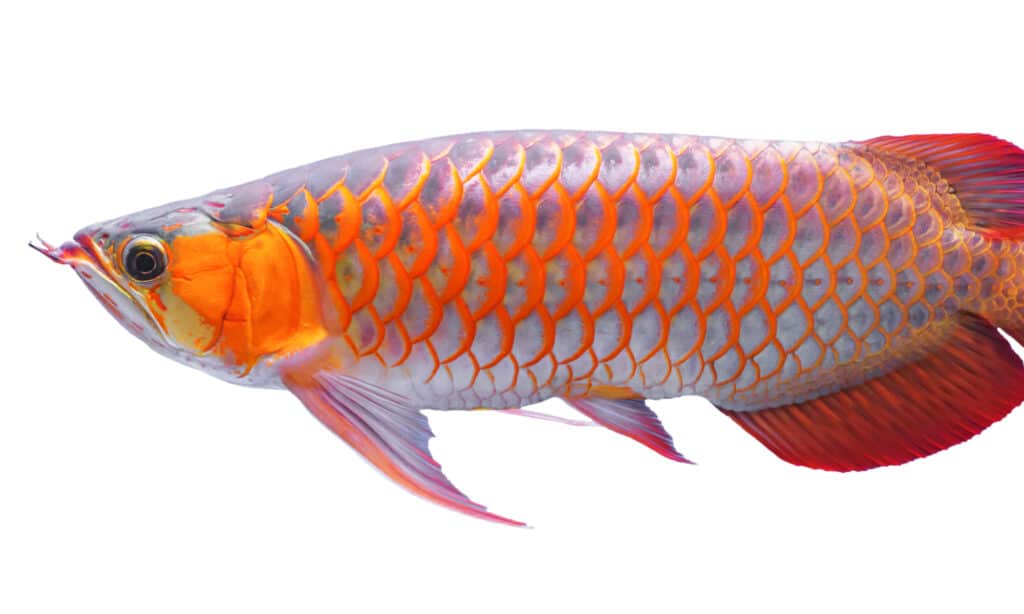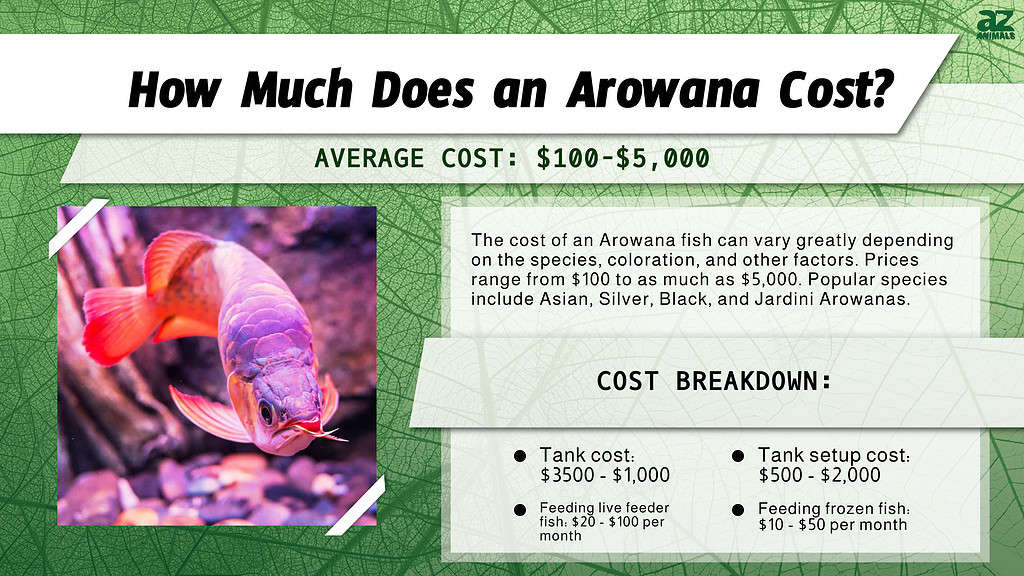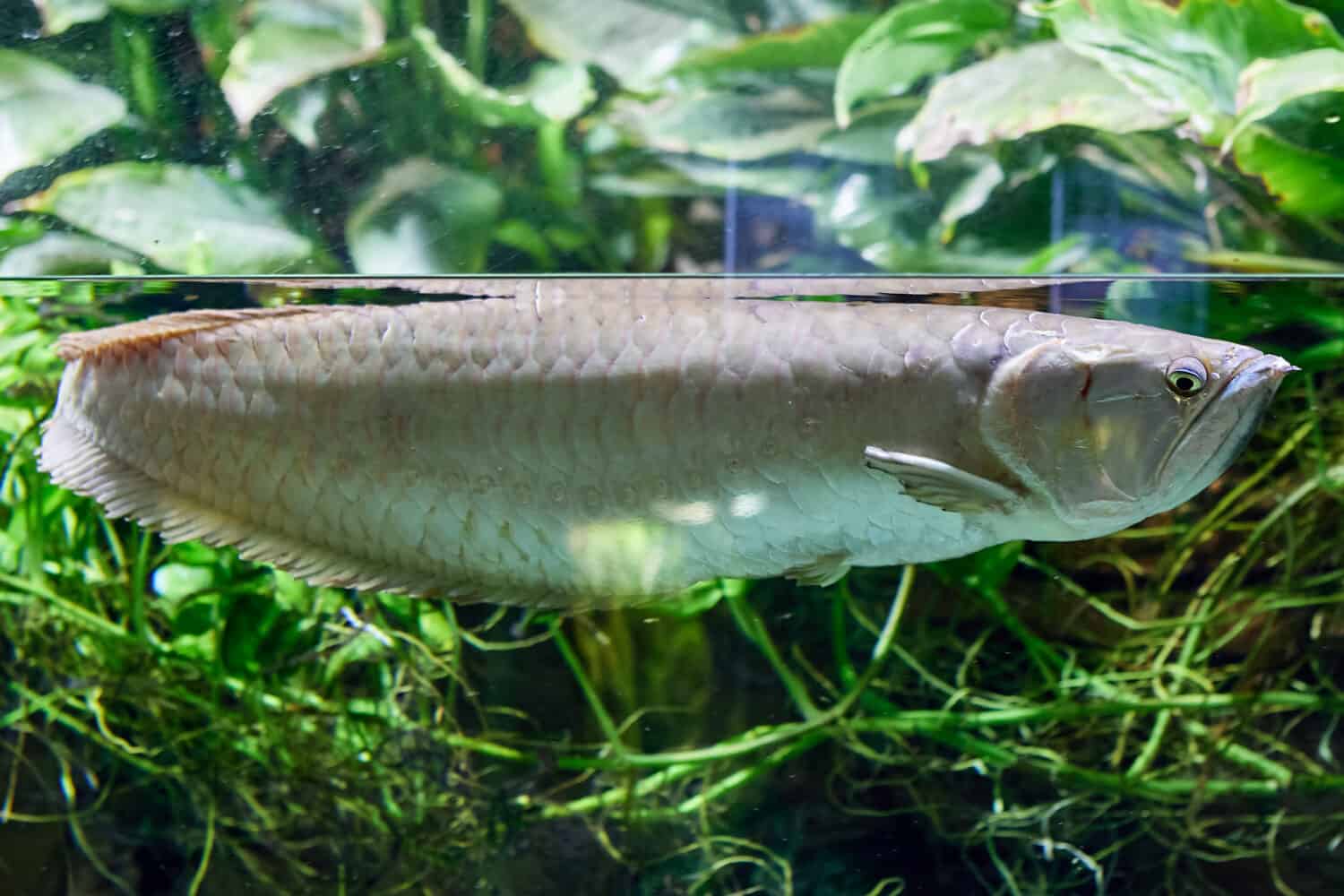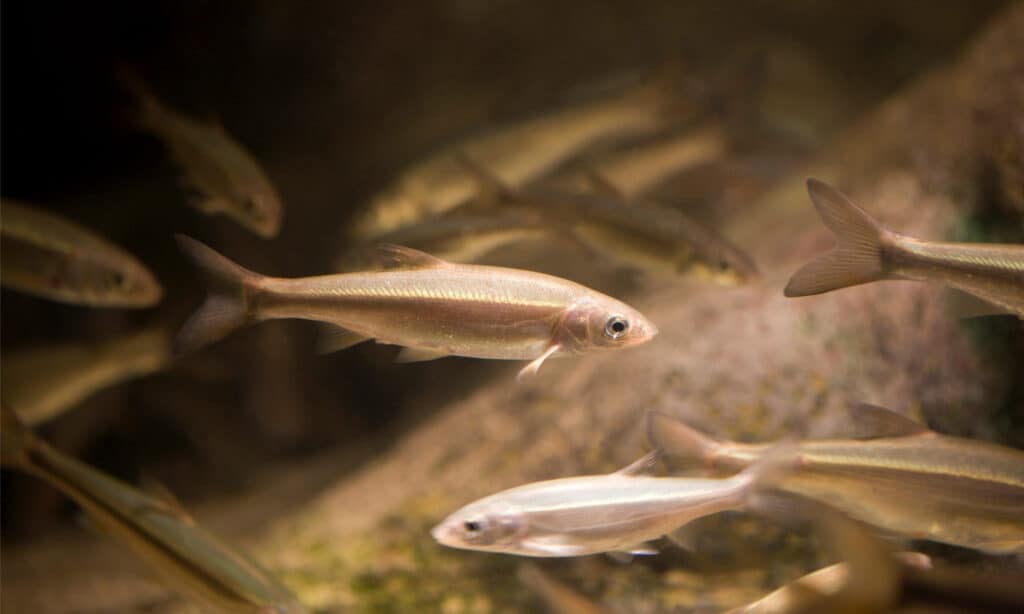Arowana fish remains one of the more popular aquarium species. They can be unique and captivating in just about any aquarium. Their striking beauty keeps them relatively popular. Therefore, they are still one of the most coveted aquatic pets.
Because they are one of the most popular aquarium fish, they can sometimes be expensive. It’s important to consider the costs of an Arowana before purchasing one, especially if you want a rarer coloration.
You also have to consider the tank setup (which can cost quite a bit, honestly) and food cost for keeping one of these fish.
Let’s dive into how much these fish cost to determine if they are the right species for you.
Arowana Species and Varieties

The Asian Arowana is one of the most coveted Arowana fish species and is illegal in the United States.
©Arunee Rodloy/Shutterstock.com
The Arowana species is quite diverse, and different variants will have slightly different costs. Therefore, it’s essential to familiarize yourself with different kinds of Arowana fish before heading to the store.
- Asian Arowana: This species is one of the most popular. It comes from Southeast Asia and is available in several different color varieties, including red, golden, and green. However, they can also command high prices due to their popularity and are illegal in the United States.
- Silver Arowana: This species comes from South America and has a sleek, silver body (as you might guess from its name). They have a torpedo shape. While still elegant, they can be more affordable than other species.
- Black Arowana: Native to the Amazon basin, the black Arowana stands out thanks to its distinct coloration. Their unique appearance makes them a favorite among collectors. However, their price can vary widely.
- Jardini Arowana: Native to Northern Australia and New Guinea, the Jardini Arowana is recognized for its intricate patterns and vibrant colors. They are often more budget-friendly than their Asian counterparts.
The exact kind of Arowana will have a huge effect on the price. Often, species that are more sought after and rare demand a higher price. Asian Arowanas tend to be more expensive, especially those with vibrant red and golden colors. In some cultures, they also hold a cultural significance that can make them even more expensive.
Silver Arowanas are more readily available, making them more budget-friendly. However, any species can be expensive, depending on other factors. Fish with unusual colors, sizes, or other features will likely cost more than average.
Different Arowana species often demand different care, too. Some may require a larger tank, which increases the cost of keeping these fish. You may also need to meet specific water conditions. Some species are particularly finicky, making them harder to care for.
Before purchasing a particular species, be sure you understand the underlying cost of its care.
Other Factors Influencing Price

Very colorful fish tend to cost most than more subdued options.
©Songsak Pandet/Shutterstock.com
Several other factors can influence the price, too. Generally, the prices of these fish vary due to supply and demand. If there are many of a particular Arowana available, then the price may be lower. Very rare fish often have a higher price tag, as there aren’t enough of them to go around.
Arowana prices overall tend to decrease as they become more popular and more breeders introduce them to the market. Many Asian countries have tons of these fish, so their prices may be lower than in Western countries.
Breeding these fish is complicated and time-intensive. Therefore, their prices will almost always be higher than easier-to-breed species. It is simply harder to make more of them.
Here are the factors that tend to affect Arowana prices:
- Rarity and availability: The rarity of certain Arowana species or color morphs can significantly affect their prices. For example, Asian Arowanas from specific regions, such as the Red Dragon variety from Malaysia, are known for their scarcity and can command astronomical prices among collectors.
- Size and age: Arowanas tend to grow slowly, though this can vary. The size and age of the fish can affect the price. Larger, more mature fish are usually more expensive due to the time put into their care. Plus, larger fish are often more sought after.
- Unique features: Fish with unique features tend to be more expensive. If a fish is particularly bright to intensely colored, they tend to command a higher price. Unique characteristics like their fin shape or distinctive markings may also increase their price.
- Breeder reputation: Some breeders are known for breeding particularly healthy fish. Often, these breeders will charge more, as their services are more highly sought after. They may maintain specifically high-quality standards or offer health guarantees.
- Legal considerations: Arowanas are protected under the Convention on International Trade in Endangered Species of Wild Fauna and Flora (CITES) due to their conservation status. Rules involving the trade and importation of these fish can affect price.
Arowana Prices

As we’ve already stated, the price of these fish can depend on many different factors, including the species and coloration. However, here’s a general idea of what you can expect:
- Asian Arowana: These are the most expensive Arowana fish. They can range from a few thousand dollars to even more than that.
- Silver Arowana: Silver Arowanas are relatively more affordable, typically ranging from $100 to $1,000, depending on their size and appearance.
- Black Arowana: Black Arowanas are sought after due to their unique coloration. They often cost between $500 to $5,000, though this can vary a bit.
- Jardini Arowana: Jardini Arowanas are often more budget-friendly, with prices ranging from $50 to $500.
There are many ways to save money on these fish if you don’t want to spend hundreds on a fish. Younger fish are often cheaper than adults, as they haven’t been raised for as long. However, the chance of health problems is higher, and you’ll have to raise the fish to adulthood yourself.
Local breeders may be cheaper than national breeders. You’ll also have the chance to inspect the fish in person, ensuring you get a better specimen. Consider attending an aquarium show, where you can often find reasonably priced fish. However, there isn’t a guarantee you’ll find exactly what you’re looking for at one of these shows.
Online platforms also provide a wide selection, allowing you to compare prices. However, be cautious about scams.
Arowana Supplies and Tank Setup

Image: Grigvovan, Shutterstock
©Grigvovan/Shutterstock.com
Before you purchase an Arowana, you also have to consider the setup required for these fish. As larger fish, they require quite a bit of room, which can be expensive. Here’s a quick list of necessary supplies:
- Aquarium Tank: You’ll need a sizable tank for an Arowana. For some species, as big as a 150-gallon tank is required. More is usually better.
- Filtration System: A robust filtration system is preferred. Both a mechanical and biological filter is required to keep the tank water clean and healthy.
- Heater: Most Arowana fish require a heater to keep the water temperature in the preferred range.
- Thermometer: In the same category, you will need to purchase a thermometer to keep up with the temperature.
- Substrate: An appropriate substrate is also necessary. However, this usually doesn’t cost all that much.
- Decorations: Aquatic decorations and hiding spots, such as driftwood or rocks, to create a comfortable and stimulating habitat.
- Aeration System: To keep the oxygen level high enough, you’ll need to purchase an aerator for your fish tank.
- Lighting: If you have any live plants, you’ll need to consider purchasing some sort of lighting for your tank. It can also make the tank look better.
- Water Testing Kits: Testing kits for monitoring the water quality are highly recommended, as this helps ensure the water stays safe for your fish.
- Water Conditioners: You’ll need to dechlorinate tap water before you add it to your fish tank.
So, How Much Does This Cost?
As you might guess, the cost of setting up an Arowana tank varies widely. If you shop sales and purchase second-hand, you may pay much less than someone who only purchases everything new. There are ways to save money, but they usually require more effort (such as keeping up with when sales are).
You may spend a minimum of $500 to set up a tank, or you may spend as much as $2,000. The tank will be the biggest expense, which can range from $300 to $1,000.
Arowana Diet and Feeding Cost

Minnows are peaceful, small fish that are available in a variety of types and colors. Arowana fish
loveto eat them.
©iStock.com/y-studio
Most fish are pretty inexpensive to feed. However, Arowanas are bigger, so they often cost more. They simply eat more food.
Arowanas are carnivorous fish, and their diet primarily consists of live or frozen prey. Here are some common food sources captive Arowanas eat.
- Live feeder fish: Fish like guppies, goldfish, and minnows are a staple for an Arowana’s diet. Luckily, most of these are pretty inexpensive.
- Insects and Crustaceans: In the wild, these fish would also eat some insects. Therefore, you may want to mirror this in captivity.
- Pellets and Commercial Food: You can also feed your fish pellets or freeze-dried food to provide some essential nutrients.
Which option you’ll choose depends on your budget and what’s available locally. Most of these food options are not available online, so you’ll need to go to your local pet store.
Feeder fish are a natural and nutritious option. They don’t require much upfront cost, but they can add up over time. Local prices will affect the cost substantially. Some feeder fish will be cheaper than others, as well. Feeding only live feeder fish may cost you $20 to $100 a month.
Frozen fish are a more convenient option. However, they can be expensive, depending on where you’re located. It’s more cost-efficient to purchase them in bulk. Frozen fish usually cost around $10 to $50 per month if that’s all your fish eats.
High-quality Arowana pellets are a great option, as they are formulated to meet their nutritional needs. Feeding at least some pellets is recommended to ensure your fish is getting all the nutrients they need. Pellets may cost $10 to $30 for a month’s supply.
Occasional live insects can provide variety, but they don’t provide these fish with everything they need, and they can be expensive.
Food rotation is also a good choice. This option allows you to provide your fish with some variety, which also helps them maintain a balanced diet. Just like humans, your fish doesn’t need to eat only one thing.
Resources and Purchase Options
Here is a list of resources to learn more about these fish, as well as places to purchase online:
The photo featured at the top of this post is © LIUSHENGFILM/Shutterstock.com
Thank you for reading! Have some feedback for us? Contact the AZ Animals editorial team.







